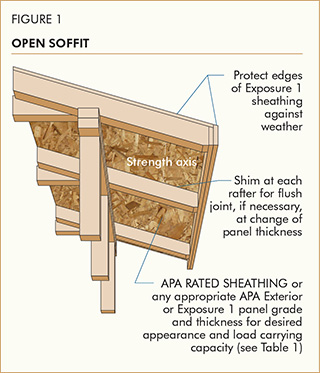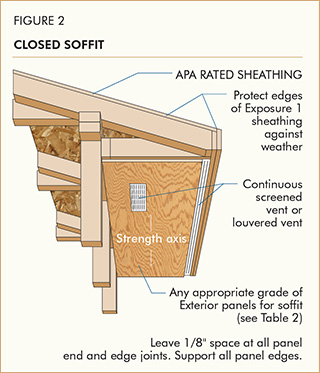APA Panels for Soffit Applications
APA trademarked panels can enhance the appearance of almost any roof overhang. Quality APA panels are also an appealing alternative to other materials used in soffit applications. Other advantages include:
- Stiffness and strength
- Lightweight
- Negligible shrinkage, warping, or twisting
- Ease of fabrication and installation
- Availability
There is a variety of APA face grades from which to choose. Selecting the appropriate panel depends primarily on whether the soffit is open or closed.
Recommended spans for open and closed panel soffits are given in Table 1 and Table 2. The recommendations in Table 1 for open soffits also apply to combined roof/ceiling construction. Panels are assumed continuous over two or more spans with the long dimension or strength axis across supports for both applications. For appearance purposes in open soffit construction, provide adequate blocking, tongue-and-groove edges, or other edge support such as panel clips. Minimum capacities are at least 30 psf live load, plus 10 psf dead load.
For open soffit construction, panels designated Exposure 1 may be used.
Exterior panels should be used for closed soffits (Figure 2). In open and closed soffit construction where Exposure 1 sheathing is used for roof decking, protect panel edges against direct exposure to the weather with fascia trim.


Finishing. Although unsanded and touch-sanded grades of plywood are often used for soffits, optimum appearance and finish performance is achieved by using panels with Medium Density Overlay (MDO), or textured (such as APA 303 Siding) or sanded A-grade faces. Top-quality acrylic latex house paint systems perform best and are the only systems recommended for A-grade faces.
Face checking (separation between fibers parallel to the grain of the face veneer) can be expected on non-overlaid plywood which is exposed to the outdoors, even when finished. If a smooth, check-free surface is desired, use MDO plywood. Surface flaking of some Exposure 1 panels is normal in this application.
Additional Information. For complete plywood or other structural wood panel application recommendations, visit the APA Publication Library and refer to:
• Engineered Wood Construction Guide, Form E30
• APA Product Guide: Performance Rated Sidings, Form E300
We have field representatives in many major U.S. cities and in Canada who can help answer questions involving APA trademarked products. For additional assistance in specifying engineered wood products, contact us:
APA HEADQUARTERS: 7011 South 19th Street, Tacoma, Washington 98466 • (253) 565-6600 • Fax: (253) 565-7265
APA PRODUCT SUPPORT HELP DESK: (253) 620-7400 • E-mail: help@apawood.org
Disclaimer: The information contained herein is based on APA – The Engineered Wood Association's continuing programs of laboratory testing, product research, and comprehensive field experience. Neither APA, nor its members make any warranty, expressed or implied, or assume any legal liability or responsibility for the use, application of, and/or reference to opinions, findings, conclusions, or recommendations included in this publication. Consult your local jurisdiction or design professional to assure compliance with code, construction and performance requirements. Because APA has no control over quality of workmanship or the conditions under which engineered wood products are used, it cannot accept responsibility for product performance or designs as actually constructed.
Form No. N330K/May 2013
© 2014 APA – The Engineered Wood Association. All Rights Reserved.

